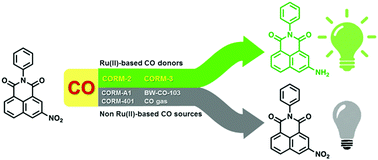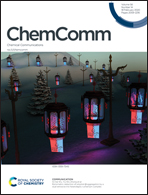Nitro reduction-based fluorescent probes for carbon monoxide require reactivity involving a ruthenium carbonyl moiety†
Abstract
Recently, several arylnitro-based fluorescent CO probes have been reported. The design was based on CO's ability to reduce an arylnitro group for fluorescence turn-on. In this work, we assessed the response of three published arylnitro-based fluorescent CO probes, namely COFP, LysoFP-NO2, and NIR-CO toward CO from various sources. We found that only ruthenium-based CO releasing molecules (CO-RMs) were able to turn on the fluorescence while pure CO gas and CO from other sources did not turn-on the probe in the absence of ruthenium. Further experiments with different ruthenium complexes indicate that the reduction of arylnitro group requires the ruthenium carbonyl complex as an essential ingredient. As further confirmation, we also conducted the reduction of the nitro group in a p-nitrobenzamide compound and came to the same conclusion. As such, COFP and related arynitro-based probes are able to sense CORM-2 and CORM-3, but not CO in general. Our findings also indicate the need to use CO from various sources in future assessment of new CO probes.



 Please wait while we load your content...
Please wait while we load your content...